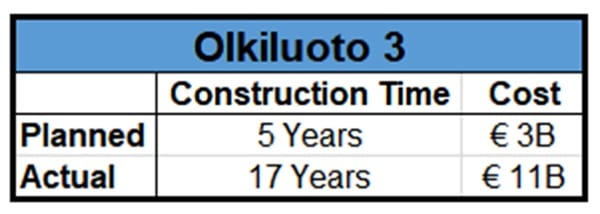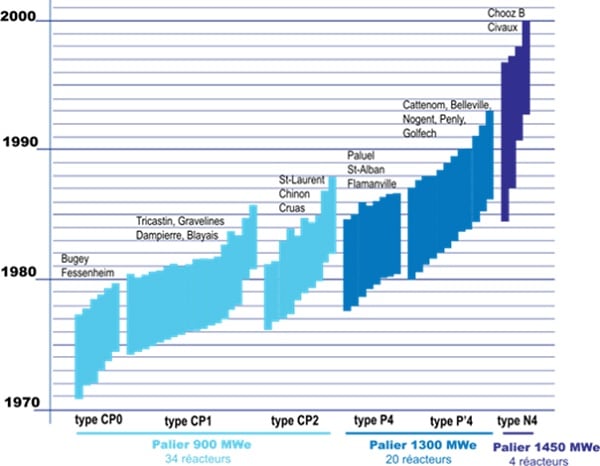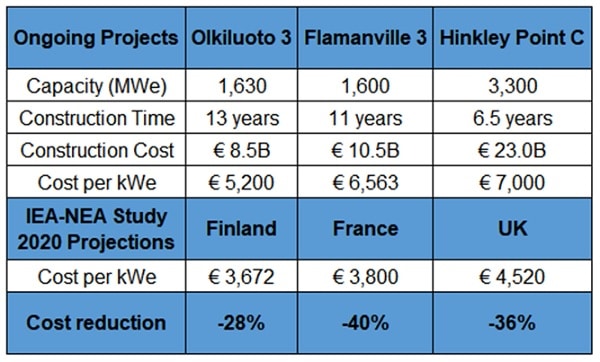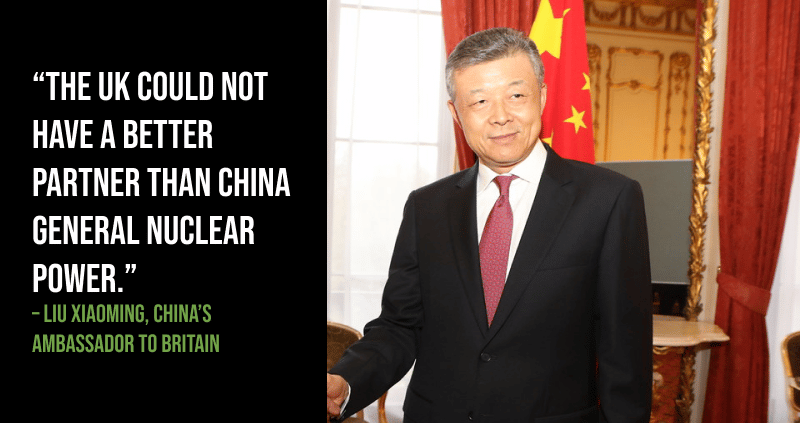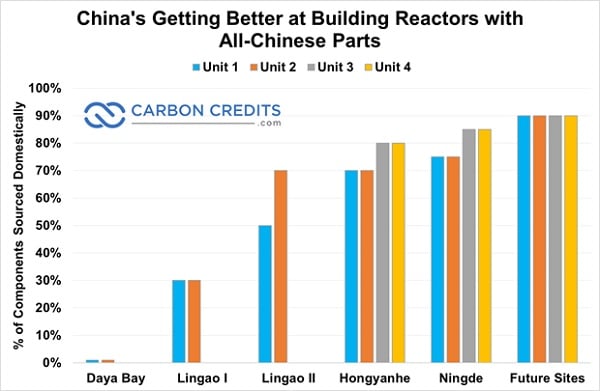Those are the names of nuclear reactors under construction in Finland, France, and the United Kingdom. On the surface, they look like utter failures.
They’ve been subject to repeated delays. Olkiluoto 3 began construction in 2005, and is finally being wrapped up seventeen years later.
The reactors’ total price tag has exploded from $26.5 billion to $55.9 billion over the course of their construction.
All of the reactors are EPRs, which were designed by France, and they’re being built by a French-owned company EDF (Électricité de France).
But eight years ago, France decided to cap energy power from nuclear at 50 percent of electricity generation by 2025. That’s down from its current 70 percent.
So why is a country that wants to reduce its reliance on nuclear… wasting tens of billions of dollars and multiple decades to build more reactors?
- It’s not to lower carbon emissions. France already has one of the lowest emissions-per-capita rates in the EU.
- And it’s not for energy security. In 2020, France was the largest exporter of electricity in the EU.
No, the real reason is much, much bigger than either of those.
The French government knows that demand for nuclear energy is about to spike. And the first country that can build inexpensive, safe, replicable nuclear reactors will have the most valuable company on earth in short order.
So the reason why France is desperate bid to build nuclear power is simple.
France wants to sell the solution to the greatest danger the planet has ever faced.
Vive La French Nuclear
The reactors being built are prototypes for full-scale, French-style nuclear reactor production.
When France built out its nuclear fleet in the ‘80s, its strategy was to achieve a “series effect”—decreasing timelines and lowering costs by building many of the same thing.
It worked. France saw major construction timeline and price reductions for each successive reactor.
And they’re doing it again. The objective with the current buildout is to reduce the costs and construction timeline for future EPRs by 30 percent.
According to the French Nuclear Energy Society, the buildout could go even further, reducing construction and financing costs by up to 50 percent.
It will also serve to revitalize France’s competency in building nuclear reactors.
In building the Flamanville reactor, France has rebuilt an entire European supply chain that is qualified to build nuclear-quality parts for nuclear power reactors.
France already has what it needs to go global with nuclear.
It’s long been a large exporter of nuclear technology, including fuel products and services. And it has experience across the entire market, from uranium mining to reactor design and construction.
According to France’s Atomic Energy Commission, there will be “a real market for EPRs” beginning in 2030.
But France might not have to wait that long. In 2021, the VP of EDF hand-delivered an offer to build the most powerful nuclear energy site in the world—9.6 GWe of EPRs on a single site.
According to leaked communications, India is paying a “high price” for these French reactors.
Which means that every country with the finances, state backing, and nuclear programs to pull this off—China, Russia, the United States, and South Korea—wants to get in on the action.
The payoff for the first country to export nuclear technology at an international scale will be oil-industry huge.
Which is why those countries are already buying… bribing… stealing… doing whatever it takes to win the most valuable market on earth.
The Real China Syndrome
That’s how Maureen Kearney found herself hooded, tied to a chair, gagged, and brutally attacked with a knife in her Paris home.
Maureen was a major union leader at Areva, a French nuclear company.
And in 2012, she had discovered that EDF was preparing to sell French nuclear secrets to a Chinese consortium.
Fearful that cutting-edge technology would be handed over to the Chinese, she decided to become a whistleblower. And she paid the price for it.
But it didn’t matter, because China found another way in.
In 2016, EDF suddenly had a new partner in Hinkley Point C: China General Nuclear Power (CGNP). CGNP now owns 34 percent of the project.
Not quite.
Because at the same time as it purchased a stake in Hinkley Point C, CGNP quietly began building two EPR reactors in China.
It’s obvious where this is going…
The first European Pressurized Reactor (EPR)—the most advanced commercial reactor design on the continent—didn’t start up in Europe.
It started up in China, six years after Maureen was attacked.
Decades of engineering and planning, construction delays, and cost overruns, all borne by France, paid huge dividends for China.
China even poached project managers from Olkiluoto and Flamanville for work on the new reactor. Experience in France meant that engineering teams worked 60 percent fewer hours on the Chinese EPR than on Olkiluoto 3, reducing costs.
A day after the first EPR launched, the most advanced commercial reactor design from the United States, the AP1000, started up for the first time… also in China.
In 2009, American company Westinghouse had agreed to work with China to develop a larger version of their AP1000 model, creatively named the CAP1400.
The agreement gave China full IP rights for all co-developed plants greater than 1350MWe.
So China is only building plants greater than 1350Mwe.
They plan to follow the CAP1400 with a CAP1700… then a CAP2100 design—the largest nuclear reactor in the world by far.
The first two units of the CAP1400, the first “fully native” Chinese nuclear reactor, are currently under construction and expected to come online in 2025.
China has openly bragged that the CAP1400 broke a number of “technological monopolies”. And that all the key materials are designed by and manufactured in China.
The design is being developed for deployment in high numbers across China, as well as for export around the world.
Neither the EPR or the AP1000 is yet online in its home country—the AP1000s in the U.S. were cancelled—but China could care less.
They leeched their technology from France, and now France is actually worse off in its ability to build nuclear power plants.
Meanwhile, China is actively building high numbers of what is possibly the safest production-level reactor there is.
More importantly, they’re rapidly preparing to bring it to the global market at the largest scale in human history.

